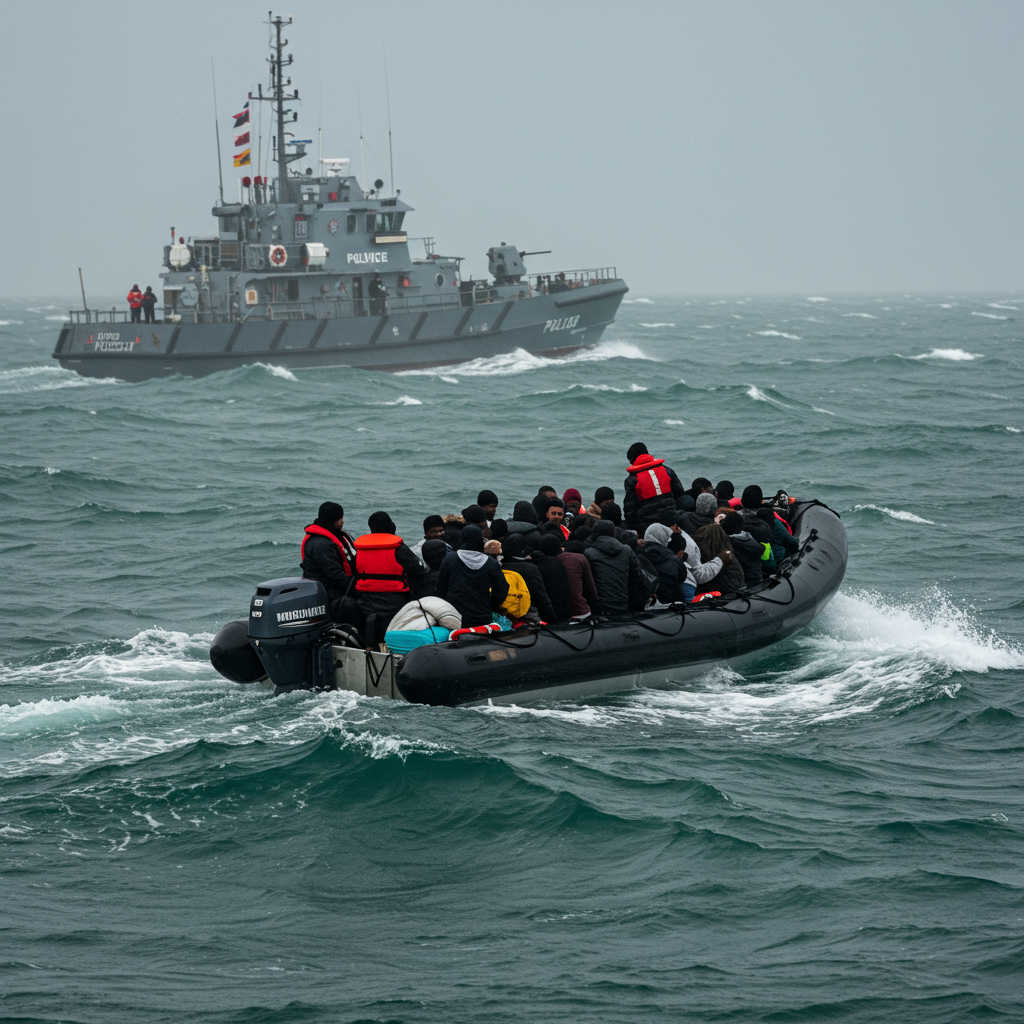Escalating Crisis: Smugglers Adapt with ‘Taxi Boats’
The English Channel is currently witnessing a potentially record-breaking surge in migrant crossings, straining French police efforts despite claims of intercepting a significant number of boats. As weather conditions clear, a growing network of smuggling gangs is rapidly adapting tactics, shifting from traditional beach launches to more clandestine methods, including the widespread use of so-called “taxi boats.” This has led to a deteriorating situation, prompting new responses from both French and UK authorities.
The sheer scale of crossings is increasing dramatically. As of mid-2025, over 14,812 migrants have reportedly reached the UK in more than 260 boats, marking a significant 32% rise compared to the same period in 2024 and setting a new record for the first six months of any year since crossings began in 2018. Recent days have seen particularly high numbers, with one day recording 1,195 successful interceptions in the Channel. Experts like the EU border agency Frontex warn that smuggling networks are continually evolving their strategies to maximize successful crossings.
How the ‘Taxi Boat’ Tactic Works
Instead of openly inflating boats on coastal dunes where police patrols are common, smugglers are moving their operations inland. They prepare the large inflatable vessels in hidden locations, such as sheds or farm buildings, often dozens of kilometers from the main departure points.
These fully inflated boats are then transported quickly to secluded beach locations. In one instance observed near Audresselles, a black Volvo V50 was found stuck on a shingle beach, its doors open, still bearing the cords used to tie a large inflatable to its roof. The boat had been rapidly driven to the water’s edge, untied, dragged the final few metres, and launched within seconds.
Once launched, these boats cruise along the coastline, acting much like buses or taxis. Their “passengers” – migrants who have often arrived in smaller groups by bus or on foot – wait in the sea, frequently in waist-deep water, safely out of reach of police patrols on the shore.
An eyewitness account from a beach near Wissant, south of Calais, described approximately 80 people, including women and children from countries like Eritrea and Afghanistan, gathered in calm, waist-deep water just before sunrise. As eighteen French gendarmes watched from the shore, an inflatable taxi boat arrived, circling to pick up migrants who clambered aboard in relatively organized groups.
The Challenge for Police: Navigating Safety and Rules
The emergence of taxi boats highlights a key operational challenge for French law enforcement. For a long time, standing rules of engagement made it exceedingly risky for police to intervene against boats once they were in the water. Officers feared causing panic, capsizing the unstable inflatable vessels, and leading to drownings, particularly of women and children. The potential for severe legal repercussions for officers involved in interventions resulting in fatalities was a major deterrent. As union representatives noted, without explicit orders, police felt unable to act even in shallow water.
Colonel Olivier Alary, a French commander, explained that intervention was generally limited to rescue scenarios or if a boat became stuck. The priority was not to endanger lives further by attempting risky stops at sea.
However, there are signs of a shift in strategy. Recent reports indicate the French interior ministry has approved a new policy allowing interventions within 300 metres of the beaches, provided they adhere to maritime law. This has reportedly led to instances where police, equipped with riot shields, have waded into the water, deploying tear gas or pepper spray to disperse migrants attempting to board boats arriving close to the shore. While this represents a more interventionist stance, officers can still be overwhelmed by the sheer number of people involved.
Beyond ‘Taxi Boats’: Smugglers’ Ever-Changing Game
Smugglers are constantly innovating. Besides hidden launches and the taxi boat system, they are now reportedly using inland rivers and waterways as launching points before heading to collect migrants in shallow coastal areas.
Frontex also highlights the concerning rise of “simultaneous departures,” where multiple boats are launched concurrently. This tactic, while potentially putting more lives at risk, severely complicates and hinders search and rescue efforts by national authorities, making it harder for police to respond effectively to multiple incidents at once.
Another disturbing trend is the increasing density of people crammed into these flimsy dinghies. Home Office data shows the average number of migrants per boat rose to 54 in the year ending March 2025, up from 50 in 2024 and 29 just three years prior. This overcrowding makes the journeys even more perilous.
The ‘taxi boat’ system, while offering smugglers more control than chaotic beach rushes, also presents unintended consequences for vulnerable migrants. Climbing onto a boat from the sea is difficult, particularly for those who cannot swim well, such as many women and children. One Somali woman, Luna, recounted trying to cross twelve times and being left behind repeatedly while men boarded, describing the process as “so dangerous, so risky.”
Furthermore, smuggling operations are expanding geographically. Successful launches are now being reported from locations much further south than the traditional Calais/Boulogne area, including villages over 100 kilometers away, demonstrating the widening scope of the gangs’ activities. Smugglers are also reportedly threatening local farmers who object to their clandestine operations on their land.
The French Perspective: Blaming the Pull Factor
French officials like Colonel Alary and local mayors view the fundamental driver of the crisis as the perceived attractiveness of the UK. They describe Britain as an “El Dorado” for migrants, arguing that the UK’s pull factors are the primary reason migrants travel across Europe to reach the northern French coast. From this perspective, the ultimate solution lies in the UK reducing its appeal to migrants.
In response to the escalating situation, both countries are bolstering resources. The UK government has announced increased funding for border security. Meanwhile, France is planning a more interventionist approach ahead of upcoming Franco-British discussions, including expanding its naval resources with new patrol boats specifically designed to intercept these “taxi boats” before they reach the UK.
The challenge remains immense. As former fisherman and local mayor Stéphane Pinto observes, the growing wave of migration is driven by complex global issues beyond just conflict, including climate change and economic collapse in various countries. The ongoing battle on the French coast reflects this difficult reality, a dynamic struggle where police efforts are constantly countered by the smugglers’ ruthless and ever-evolving tactics.



